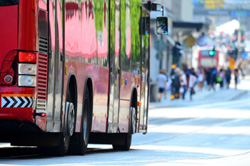|
Introduction
As cities grow and mass transportation become more popular than cars in certain parts of the world- transportation companies are starting to adopt cutting edge computer technology to increase the level of their customer’s satisfaction and decrease dangers and accidents both on and off the road. New technological innovations are paving the way for safer commutes, including sensors that help prevent vehicles against traffic collisions and alert pedestrians of upcoming bus turns; network surveillance systems that can identify drunken passengers and pedestrians for train terminals; and even self-driving buses that eliminate human errors and enhance operational efficiency. Thanks to advanced computer hardware and sophisticated software programming, the global safety scene for mass transit has become an exciting place for launching innovative systems to help prevent accidents and offer better commuting experiences to passengers.
Onboard and on the Road Public Safety: Driverless Mass Transportation Vehicles
The global mass transit scene has taken advantage of recent advancements in computer technology and used it to combat human driving errors to prevent accidents and enhance convenience. Unattended trains, for instance, have been in operation for quite some time. It was first launched in London, England in 1967. As technology progresses, the idea of driverless vehicles has become a reality. Drivers can be distracted, drunk, careless, tired, etc., which can lead to traffic jams and accidents. All around the world, the idea of the self-driving car means a safer and worry-free commute that is made possible with the advent of vehicles that utilize “smart” computers and constantly updating GPS information to drive from one destination to another.
In the past few years, most U.S. commuters may have been familiarized through the news with Google’s self-driving car project. So far, the legislatures of four U.S. States have permitted the operations of self-driving cars. In China, bus manufacturer Yutong has combined the idea of mass transportation and automated vehicles to unveil the world’s first driverless bus for mass transportation. The system incorporates a master controller, sensor system with radar and cameras, and an intelligent control system in order for the bus to drive passengers to a specified route. Utilizing all of the networked components as Yutong’s spokesperson explained, the bus can reduce its speed in high traffic areas; change lanes; avoid hazards on the road; stop at signals and traffic signs; and prevent accidents better than most skilled drivers can.
This means that the driverless bus can presumably cause less traffic congestion and reduce their carbon footprint in comparison to regular human-operated buses because of its ability to constantly evaluate its surroundings while driving at the safest speed on the fastest route and efficiently consuming less fuel.
According to a press release from Yutong, the technology has been under development for three years and completed a 20-mile trip without any incidents in August. While the driverless bus might not be ready for mass use just yet, the manufacturer noted that their test bus drove in an effective manner “that can only be attained by years of experience of an attentive and careful driver.”
Smart Network Surveillance System Detects Drunk Commuters
 China is not alone in their concerns for onboard and wayside public transportation safety. Protection of pedestrians and commuters has been the ongoing focus of mass transit operations worldwide. Intoxicated individuals taking part in mass transportation should be praised for staying out of their cars and off the roads, but the act of being intoxicated in public can still pose certain dangers that might not always be readily apparent. Train collisions with individuals are causing major concerns globally. From the U.S. National Transportation Safety Board, 2013 saw 891 rail fatalities - with 520 of those fatalities classified as “trespassers” that were struck by trains. According to a study by the Japanese Government, there were 221 cases of passengers hit by trains in 2013, either from standing too close to the platform or falling onto the tracks. About 60 percent of those hit were declared drunk at the time of their accident. China is not alone in their concerns for onboard and wayside public transportation safety. Protection of pedestrians and commuters has been the ongoing focus of mass transit operations worldwide. Intoxicated individuals taking part in mass transportation should be praised for staying out of their cars and off the roads, but the act of being intoxicated in public can still pose certain dangers that might not always be readily apparent. Train collisions with individuals are causing major concerns globally. From the U.S. National Transportation Safety Board, 2013 saw 891 rail fatalities - with 520 of those fatalities classified as “trespassers” that were struck by trains. According to a study by the Japanese Government, there were 221 cases of passengers hit by trains in 2013, either from standing too close to the platform or falling onto the tracks. About 60 percent of those hit were declared drunk at the time of their accident.
To combat this, West Japan Railway and system integrators have designed and deployed a new wayside security surveillance system that is being tested at Kyobashi train station in Japan near one of Osaka’s nightlife districts. The system and its many cameras can be programmed to automatically detect certain movements associated with inebriation including staggered or clumsy walking; standing still or remaining on the train platform for extended periods of time; and sleeping on the train station’s benches. Once the camera system recognizes these behaviors, the information and footage is delivered by the controllers managing the network to the transportation hub’s security station, where guards can be alerted and swift actions can be taken to ensure the commuter’s safety. This type of “smart” surveillance system is another step mass transportation authorities are taking to help prevent accidents and injuries that can occur not only while the passengers are on board mass transit vehicles but also during their transit.
Pedestrian Safety, the “Talking Bus”
 The Japanese transit authority‘s concerns for their commuters is echoed by the U.S. transit authority. The U.S. National Highway Traffic Safety Administration reported 32,719 traffic fatality cases in the United Stated in 2013. Among them, 4,735 were pedestrian fatalities. While the total number of traffic-related fatalities has steadily declined since the 1960’s, pedestrian fatalities have remained steady over the last decade. Improving safety standards for mass transit operations in a large metropolitan area such as New York City is undoubtedly challenging and has been the key focus of the local transportation authority. According to Darryl Irick, senior vice president of buses for the Metropolitan Transit Authority of New York City, his organization is always looking into using new technology to reduce the number of collisions each year. The New York’s Metropolitan Transportation Authority is currently embarking upon a new project. Several of its buses are being tested with two new safety-related systems - a pedestrian warning system and a collision avoidance system. The goal is to improve safety of passengers on the bus and pedestrians on the road. The Japanese transit authority‘s concerns for their commuters is echoed by the U.S. transit authority. The U.S. National Highway Traffic Safety Administration reported 32,719 traffic fatality cases in the United Stated in 2013. Among them, 4,735 were pedestrian fatalities. While the total number of traffic-related fatalities has steadily declined since the 1960’s, pedestrian fatalities have remained steady over the last decade. Improving safety standards for mass transit operations in a large metropolitan area such as New York City is undoubtedly challenging and has been the key focus of the local transportation authority. According to Darryl Irick, senior vice president of buses for the Metropolitan Transit Authority of New York City, his organization is always looking into using new technology to reduce the number of collisions each year. The New York’s Metropolitan Transportation Authority is currently embarking upon a new project. Several of its buses are being tested with two new safety-related systems - a pedestrian warning system and a collision avoidance system. The goal is to improve safety of passengers on the bus and pedestrians on the road.
The pedestrian warning system issues an audio warning to notify pedestrians when the bus is making a left or right turn. The system is triggered each time the bus starts to make a turn and speakers on the bus are placed so as not to block the driver’s vision. The volume of the warning system also accounts for the amount of noise around the bus, ensuring that the advanced warning can be heard even in louder areas.
The collision avoidance system uses multiple smart vision sensors with driver interface to detect the presence of other vehicles and pedestrians around the bus. This system continually calculates risks and provides alerts for corrective actions for the driver.
Advanced computer hardware, coupled with a comprehensive software suite, can offer more features and capabilities that help provide an extra layer of safety. These solutions can help monitor the driving habits of others while the driver focuses on the road.
Whether it’s in a bus, on a train, in transit, or on a street; safety and efficiency will always be the main focuses of mass transportation. With the constant development of new hardware and software technology, system integrators and mass transit authorities are constantly working with computer system manufacturers and software companies in order to create solutions that ensure a higher level of safety as well as enhanced operational efficiency and effective natural resource consumption. From driverless buses to talking ones, an exciting and safer world of mass transportation is ahead.
To learn more about Axiomtek’s eBOX embedded systems, tBOX intelligent transportation systems, and rBOX DIN-rail embedded controllers, contact us at info@axiomtek.com.tw.
|

